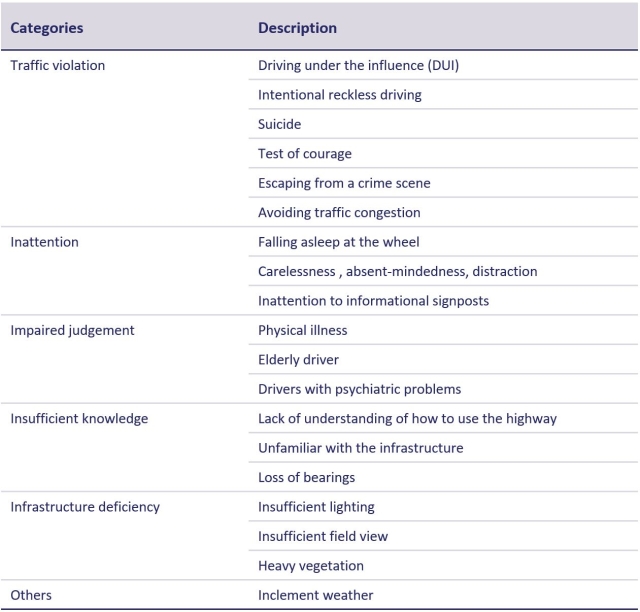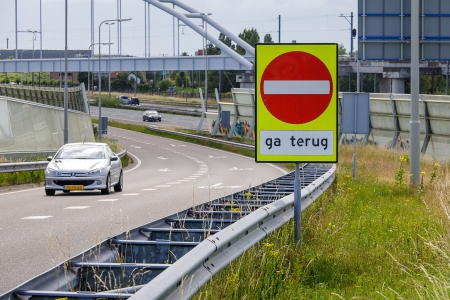Wrong-way driving can either be intentional or unintentional.
Intentional wrong-way driving
The following reasons/motives often underlie intentional wrong-way driving [1] [4]:
- The driver turns, to avoid a traffic jam (via the emergency lane) or to reach a missed exit.
- The driver attempts to turn/reverse or otherwise correct after taking a wrong entrance or exit ramp.
- The driver does it for kicks or a bet.
- The driver tries to escape a police check or pursuit.
- The driver tries to commit suicide.
Deliberate, intentional wrong-way driving is more common among younger wrong-way drivers [1] [2] [6].
Unintentional wrong-way driving
Unintentional wrong-way driving is often the result of absent-mindedness, inattention and/or orientation problems [4]. For example, drivers do not realise that they are entering a motorway exit instead of the entry ramp, or they think they are taking an ‘ordinary’ turn and do not realise at all that they are entering a motorway. The specific design of entry and exit ramps plays an important role here [1] [2]. This form of unintentional wrong-way driving is relatively common among older wrong-way drivers [1] [16] [17]. General confusion, for example due to mental issues, dementia or alcohol and drugs, can also be the cause of unintentional wrong-way driving [1].
Effect of alcohol, drugs and medication
Both Dutch and international research shows that alcohol, drugs or a combination of both are involved in many wrong-way driving crashes. Medication also plays a role.
In 18 of the 68 Dutch wrong-way driving crashes and incidents between 2015 and 2019 [1], the wrong-way driver had an alcohol level above the legal limit; in 5 of the 68 analysed crashes, the wrong-way driver was under the influence of drugs, and 1 was under the influence of both alcohol and drugs. Thus, a total of over 33% wrong-way drivers were under the influence of alcohol or drugs. Medication that can affect driving ability also plays a role. In the study mentioned above, 5 out of 68 wrong-way driving crashes and incidents involved medication. In reality, the numbers will be higher; for the police do not check all wrong-way drivers for alcohol and drugs, nor is asking about medication part of standard procedure.
In Belgium [4], 43% of the wrong-way driving crashes involved alcohol; in all crashes this is 8%. In Germany, the percentage is lower: there, 14% of wrong-way driving crashes were reported to involve alcohol [5]. These two studies do not discuss drugs and medications. US estimates of substance use among wrong-way drivers are much higher. They range from around 50% to more than 60% [8] [10] and even as high as 70% [15]. On the basis of Swiss data, the risk of a wrong-way driving crash has been calculated to be over 3.5 times higher when alcohol, drugs or medication are involved [6]. For example, drivers under the influence of alcohol have been found to have different search and viewing patterns when turning onto a motorway and to perceive certain colour contrasts on road signs less well than sober drivers [18].
Summary overview
Arranged in a slightly different way, the following overview offers a summary of the most common factors that contribute to the occurrence of wrong-way driving crashes, based on an international literature review [19].

Table 1. Summary of factors contributing to the occurrence of wrong-way driving crashes, based on an international literature review. Source: [19].
